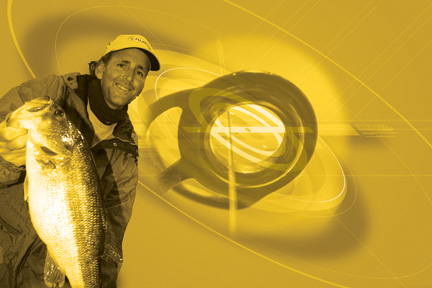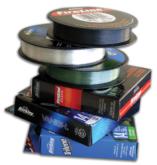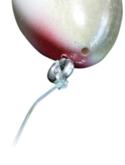Line of fire
How classic, new innovative line technologies stack up

With so many variables in fishing, anglers often overlook the most critical elements in each cast or hookset. Off the water, most coddle their equipment like newborns but then punish their equipment mercilessly while on the water. Like in the famed game show The Weakest Link, one wrong decision concerning fishing line and the words “you are the weakest link – goodbye” will echo painfully in the back of your mind as that keeper bass breaks free.
Most anglers will agree that fishing line is the most critical link between them and the fish. When hooked, a mature bass immediately seeks to put obstacles between it and the angler, oftentimes severing that link. Lines of yesteryear were only about getting fish in the boat, but new technologies in fishing line take into account many other variables to maximize their effectiveness. Now manufacturers must consider water clarity, abrasion resistance, tensile strength, line memory, stretch and a host of other variables when designing the perfect line for various bass-fishing situations.
Fujifilm pro Randy Blaukat of Lamar, Mo., has sampled and tested just about every type, color and pound-test line on the market. After winning more than $300,000 in FLW Outdoors events, Blaukat obviously learned a thing or two about fishing line along the way.
“The general rule for me over the years has been to use the heaviest line I can without losing strikes,” Blaukat said. “So many of the anglers who fish with me use too-light line.”
Keys to line choice
 For Blaukat, line choice depends on two factors – the water and the lure he chooses. In ultraclear water, especially when fishing deep, he believes lighter line will generate more detectable strikes.
For Blaukat, line choice depends on two factors – the water and the lure he chooses. In ultraclear water, especially when fishing deep, he believes lighter line will generate more detectable strikes.
“The deeper or clearer the water I fish, the lighter the line I use,” Blaukat said.
While he might flip with 30-pound-test fluorocarbon line in water less than 5 feet deep, he will downsize his line as the water gets deeper. As a general rule, he will drop line size 1 pound for every 5 feet of depth. When fishing deep, strikes are easier to detect on lighter line because the line will maintain its form all the way down the water column. With heavier line, there is a tendency for the line to coil and not stay as taut through the depths.
While water clarity and depth factor into his decision, the lure and technique will ultimately determine which line he uses. “For instance, I never throw a spinnerbait on line lighter than 20-pound-test,” Blaukat said. “There’s just no reason to take a chance on a fast-moving bait like that.”
However, Blaukat admits that a jig falls a lot slower on 30-pound line than it does on 15-pound line. He also acknowledges a crankbait will run deeper on 10-pound line then it will on 20-pound line, so he makes his choice based on how the fish are reacting to his lure. If he feels the fish are up off the bottom or tight to cover, he might opt for a heavier line, but if the fish are right on the bottom, he might go with a lighter line to get to the fish quicker and detect bites he might otherwise miss on heavier line.
Line types and applications
The main types of lines commonly used in bass fishing today include monofilament, braided line and fluorocarbon. Monofilament offers several advantages to competitive and weekend anglers alike. An obvious advantage monofilament has over other line types is price. Anglers buy more monofilament than any other type of line, largely because of that one factor. Monofilament has proven itself since the early 1950s to be a productive choice for catching more and larger bass. Offered in a variety of pound-tests, monofilament fills most needs, not to mention that recent advances in monofilament production resulted in lines with greater abrasion resistance and lower stretch like Berkley Trilene XT.
In the early 1990s, companies began manufacturing a new type of superline called braided line. Braided line often yields the strongest possible line at the smallest diameter available, and when fishing specific applications that require a no-stretch hookset in dense vegetation, braided lines produce better than other lines. Many of the anglers who finish high in the FLW Tour event on Lake Okeechobee each year flip jigs and worms on heavy braided line. With this type of line, anglers whip solid hooksets and forcibly pull bass free of thick mats of vegetation.
“I fish Seaguar fluorocarbon line exclusively on all my rods now,” Blaukat said. “Like most anglers, it was hard for me to make a change from the monofilament lines I’ve always fished because I was comfortable with them.”
After some coaxing from his friends, however, Blaukat started experimenting and testing other types of lines on the market. The convincing factors for him included high abrasion resistance and low visibility. In keeping with his “as-big-as-I-can-afford” line philosophy, Blaukat finds that fluorocarbon lines fit his fishing style better than monofilament or braided lines.
 Line color
Line color
While manufacturers offer a rainbow of colored lines, most anglers will stick with the top three colors, which are clear, blue and green. When fishing monofilament, color choices include those colors as well as smoke, camouflage and even fluorescent hues. Keep in mind, however, that companies manufacture those line colors for very specific types of fishing. The key factors in choosing a line color tend to be visibility to the fishermen and visibility to the fish. While anglers fishing at night like a line that will show up under their fluorescent lights, daytime anglers generally want a little more camouflage.
“Fluorocarbon line generally only comes in clear because of its refractive properties under the water,” Blaukat said. Fluorocarbon lines, like Berkley Vanish, become invisible under the water’s surface. Therefore, anglers employ heavier lines without worrying about spooking the fish. Clear lines may make for better fishing below the surface but oftentimes require acute eyesight to watch your line for otherwise unperceivable strikes.
While fluorocarbon lines are invisible to most, braided lines definitely are not. Generally, braided lines come in smoke or a fluorescent variety for applications where watching your line is imperative and the water clarity or cover reduces the bass’s ability to see your line. Because of the materials used to create braided line, invisibility poses a problem for most manufacturers. However in certain situations, the tradeoff between invisibility and raw strength and zero stretch makes perfect sense.
Blaukat has fished with most of the lines out there and found a line type in various sizes that works for him. The key to being successful at anything is confidence. His confidence was gained through experimentation and experience, and it may not work for everyone else. Take time to experiment with the new types, colors and sizes of lines on the market today. Blaukat, like many anglers, learned that as fishing technologies evolve, so will your fishing opportunities, and it’s never too late to teach an old dog new tricks.
The reality of line care
Most competitive anglers meticulously inspect their line for nicks and abrasions after each fish caught, but many will neglect to check their line condition while away from the water.
“Fishing line is probably the only equipment I take special precautions with off the water,” Blaukat said. “I only buy bulk spools, and because of the money I invest in the line, I take care to keep my line away from temperature extremes.”
While rods, reels and most lures will withstand the effects of extreme cold or hot temperatures, fishing line is much less forgiving. “In extreme cold temperatures, line has a tendency to coil more and become more rigid and brittle,” Blaukat said. This is true of lines regardless of the type. Anglers should consider storing line separately from other gear so that it can be removed from storage and kept inside at room temperature.
Anglers should consider the memory aspect when caring for line. Being on a spindle or reel too long can cause line to take the shape of its container. This becomes especially apparent with age and temperature. To help recondition your line, Blaukat advises tying your line to a tree or post and releasing line from the bail until you get near the end. Then close the bail and pull the line taught for several minutes to help stretch the line straight. Other anglers have advised removing your lure and letting slack line out behind a moving boat to allow it to uncoil itself.
Whatever you decide, protect your investment wherever you can. Blaukat advises trying things like wetting your line before you cinch your knot and using fish attractants to wet your fingers when handling your line all day. This type of care will help you make the most out of your angling investment.